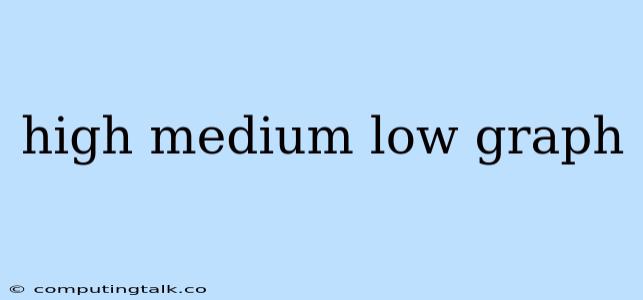The concept of high, medium, and low is a fundamental aspect of various fields, ranging from data visualization and analysis to everyday life decisions. When presented in a graph, these terms offer a visual representation of varying levels, allowing for easier understanding and comparison.
Understanding the Concept
High, medium, and low represent different levels of a particular characteristic or variable. Imagine a graph showcasing the performance of a product based on customer ratings. The high section would represent products with consistently positive feedback, the medium section would represent products with mixed feedback, and the low section would represent products with consistently negative feedback.
Application in Data Visualization
Graphs are essential for visually portraying data and trends. When depicting data with high, medium, and low values, a graph provides a clear visual representation. This is particularly useful for:
- Identifying Trends: Visualizing high, medium, and low points on a graph over time helps identify trends. For example, a graph showing sales figures might reveal a high sales period in the holiday season, a medium period during regular months, and a low period during off-seasons.
- Making Comparisons: Comparing different sets of data using high, medium, and low values on a graph allows for easier understanding of relative performance. For instance, comparing sales figures of different products using a graph with high, medium, and low values can highlight the best-performing product.
- Communicating Data: Graphs with high, medium, and low values provide a concise and effective way to communicate data to a wider audience. This is particularly beneficial for reports, presentations, and other forms of communication.
Tips for Effective Use
- Choose Appropriate Scale: Selecting the right scale for the graph is crucial. A scale that effectively represents the high, medium, and low values is important for visual clarity.
- Use Clear Labels: Labeling the graph axes and key data points with high, medium, and low descriptions enhances understanding.
- Consider Color and Style: Using contrasting colors and line styles can further enhance the visual representation of high, medium, and low values.
- Avoid Clutter: Keep the graph clean and uncluttered to prevent confusion.
Practical Examples
- Temperature: A weather graph might display temperature readings as high, medium, and low for different time periods.
- Website Traffic: A graph showing website traffic could categorize it as high, medium, or low based on daily or hourly visits.
- Customer Satisfaction: A graph tracking customer satisfaction surveys could represent responses as high, medium, or low based on ratings.
Conclusion
The concepts of high, medium, and low provide a clear and effective way to categorize and represent data, particularly when visualized using graphs. This framework offers valuable insights into various fields, enabling easier analysis, comparison, and communication of information. By understanding the principles of high, medium, and low values and their representation in graphs, individuals can gain a deeper understanding of data and trends across various applications.
